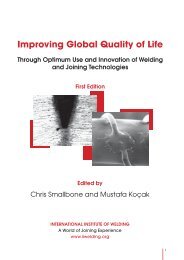The Comparison of Microstructure and Mechanical Properties of
The Comparison of Microstructure and Mechanical Properties of
The Comparison of Microstructure and Mechanical Properties of
Create successful ePaper yourself
Turn your PDF publications into a flip-book with our unique Google optimized e-Paper software.
FCW types are generally grouped as rutile, basic, metal,<br />
stainless <strong>and</strong> hard facing. <strong>The</strong>re are two basic process<br />
variants; self shielded FCAW (without shielding gas)<br />
<strong>and</strong> gas shielded FCAW (with shielding gas). <strong>The</strong><br />
difference between them stem from different fluxing<br />
agents in the consumables, which addresses different<br />
needs <strong>of</strong> different customer segments.<br />
Figure 1. <strong>The</strong> FCAW process<br />
As it is known, the primary function <strong>of</strong> the shielding gas<br />
is to protect the molten metal from atmospheric N 2 <strong>and</strong><br />
O 2 as the weld pool is being formed. <strong>The</strong> gas also<br />
promotes a stable arc <strong>and</strong> uniform metal transfer. It also<br />
affects the spatter rate <strong>and</strong> penetration pattern [6]. <strong>The</strong><br />
most common shielding gases: are C0 2 <strong>and</strong> Argon-CO 2<br />
mixtures for FCWs. Traditionally, CO 2 is used as a<br />
shielding gas due to its cheapness, but its use has been<br />
limited because <strong>of</strong> the problem <strong>of</strong> spatter, poor allposition<br />
performance [7].<br />
On the other h<strong>and</strong>, argon alone is also unsuitable for<br />
welding steel as it cannot sustain the desired arc stability<br />
<strong>and</strong> desired weld bead characteristics [8].<br />
<strong>The</strong> flux, which is contained within the core <strong>of</strong> the<br />
tubular electrode, melts during welding <strong>and</strong> shields the<br />
weld pool from the atmosphere.<br />
Flux contains substantial amounts <strong>of</strong> deoxidizing,<br />
denitrifying ingredients, arc stabilizers <strong>and</strong> alloying<br />
elements. <strong>The</strong>se are common core ingredients for<br />
FCWs. It is known that nitrogen <strong>and</strong> oxygen can cause<br />
porosity or brittleness while oxygen significantly affects<br />
the volume fraction <strong>and</strong> morphology <strong>of</strong> the inclusions so<br />
deoxidizers such as Mn <strong>and</strong> Si <strong>and</strong> denitrifiers such as Al<br />
are added to purify the weld metal. Furthermore, slag<br />
formers such as oxides <strong>of</strong> Ca, K, Si or Na are added to<br />
protect the molten weld pool from the atmosphere.<br />
Alloying elements Mo, Cr, C, Ni, Mn <strong>and</strong> V, are<br />
generally used, in a balanced manner to increase<br />
strength, ductility, hardness <strong>and</strong> toughness. Beside this,<br />
arc stabilizers such as Ka <strong>and</strong> Na, help to produce a<br />
smooth arc <strong>and</strong> reduce spatter [4]. <strong>The</strong> design <strong>of</strong> the<br />
chemical composition <strong>of</strong> the FCWs is also needs to<br />
comprise all those above listed generally known<br />
structures <strong>of</strong> the conventional welding consumables<br />
while taking into account <strong>of</strong> the special feature <strong>of</strong> the<br />
FCW <strong>and</strong> molten metal-transfer mechanism which<br />
differs from solid wires.<br />
3. Experimental Procedure<br />
<strong>The</strong> flux cored welding method were used for production<br />
<strong>of</strong> butt-welded plates <strong>of</strong> St 52,3 steel using six different<br />
types <strong>of</strong> FCWs using ceramic backing tape <strong>and</strong> mixed<br />
gas <strong>of</strong> 80% +20% CO 2 for basic <strong>and</strong> metal cored wire<br />
<strong>and</strong> 100% CO 2 for rutile FCWs.<br />
<strong>The</strong> wires used in the study are 1.2 mm diameter <strong>and</strong><br />
conform to the AWS A5.20 specifications. Rutile wires<br />
have E71-T1 type, Basic <strong>and</strong> Metal wires have also E71-<br />
T5 type. Table 1 shows the list <strong>and</strong> types <strong>of</strong> the<br />
consumables wires.<br />
Table 1. Characteristics <strong>of</strong> flux-cored consumables<br />
Characteristic <strong>of</strong> consumables<br />
Welding Deposit Wire Type<br />
Diameter (mm)<br />
G Wire Rutile 1,2<br />
K Wire Rutile 1,2<br />
S Wire Rutile 1,2<br />
E Wire Rutile 1,2<br />
B Wire Basic 1,2<br />
M Wire Metal 1,2<br />
Test pieces were cut from welded plates <strong>of</strong> 300 mm<br />
(width) ×500 mm (length) ×15mm (thickness). This base<br />
material with a 60º V-shaped groove was used <strong>and</strong><br />
multipass (5 passes) welding procedure was carried out<br />
in flat position with the interpass temperature <strong>of</strong> about<br />
150ºC.<br />
Figure 2a. <strong>The</strong> plan <strong>of</strong> cutting for mechanical tests; tensile samples<br />
(1), bending samples (2), macro <strong>and</strong> micrography samples (3) <strong>and</strong><br />
Charpy V-Notch samples (4).<br />
<strong>The</strong> chemical analyses <strong>of</strong> weld metals, which were<br />
welded with different type FCWs, are given in Table 2.<br />
During the welding, semi-automatic welding machine<br />
was used.<br />
20
















